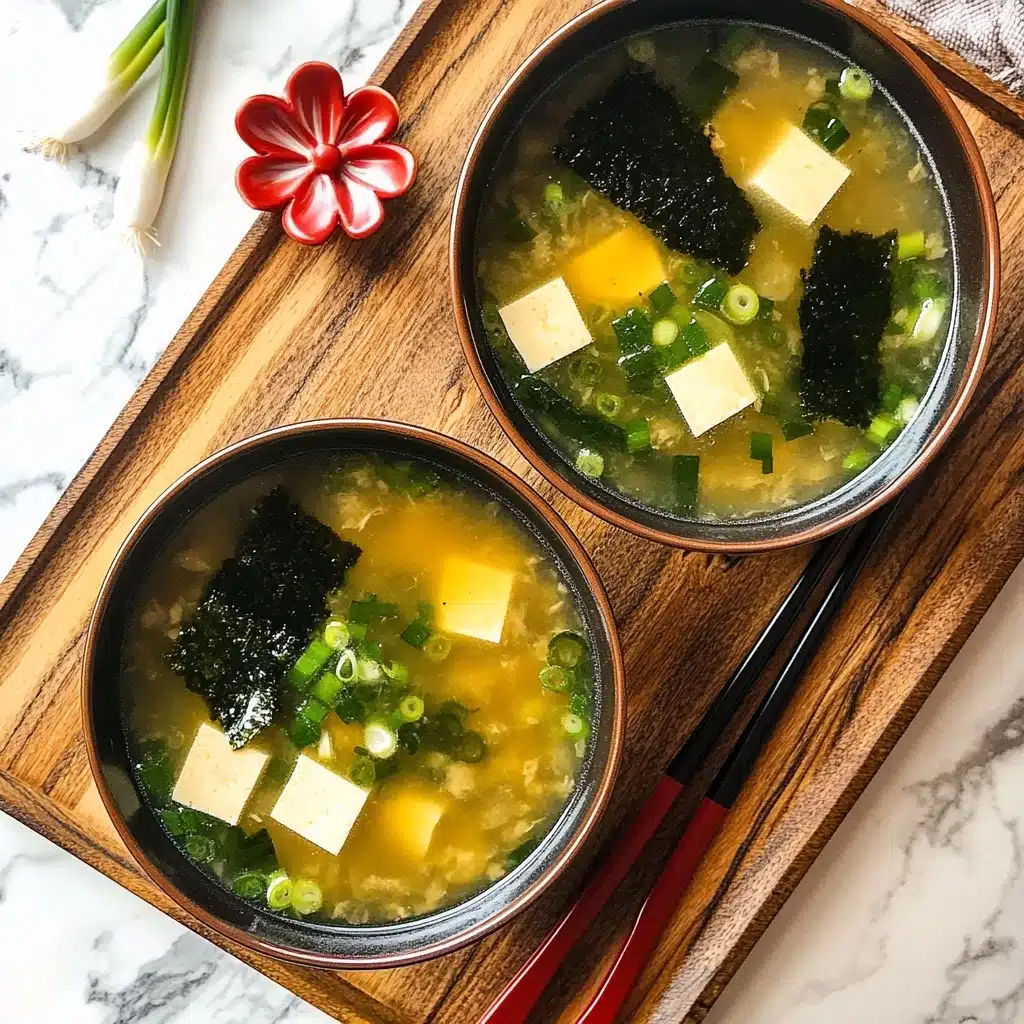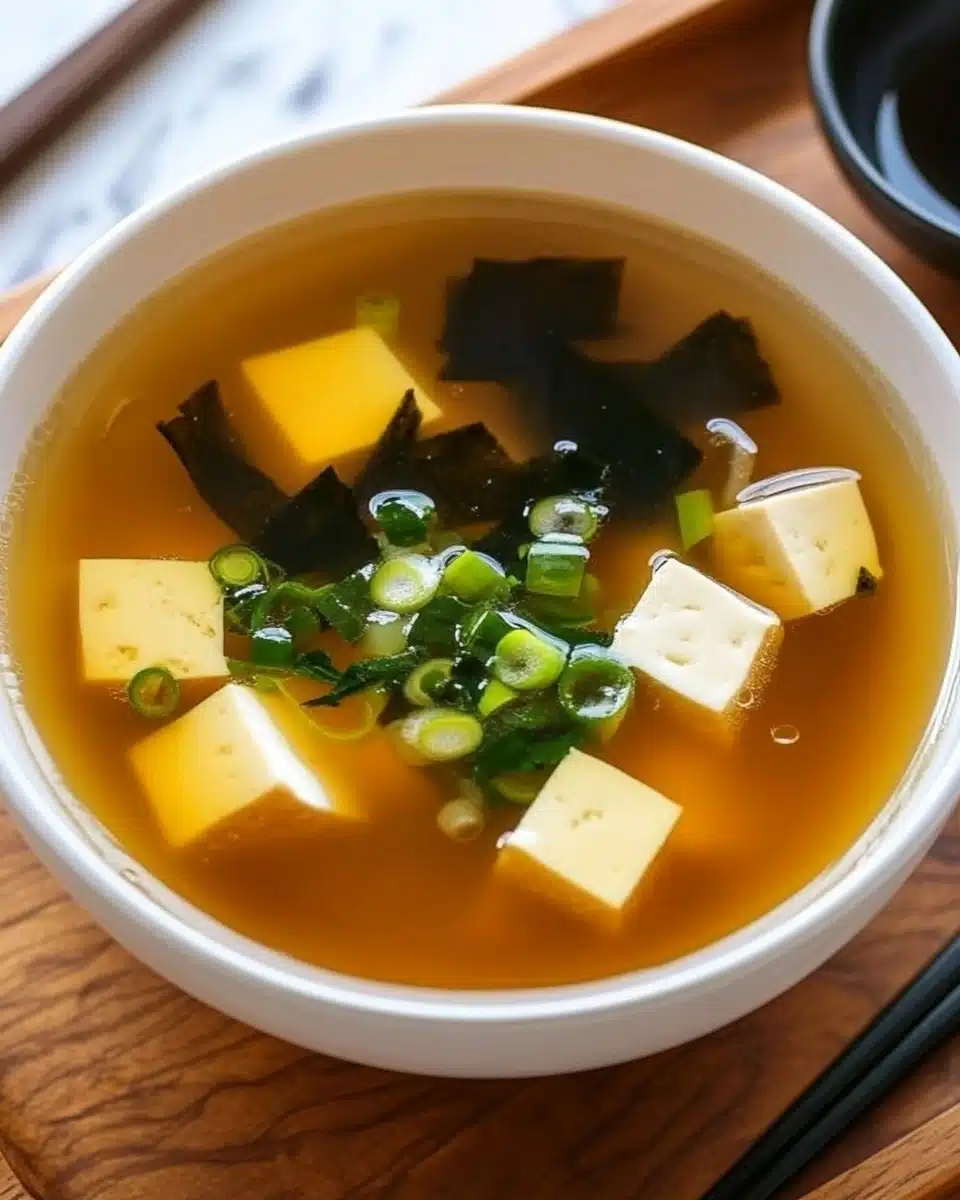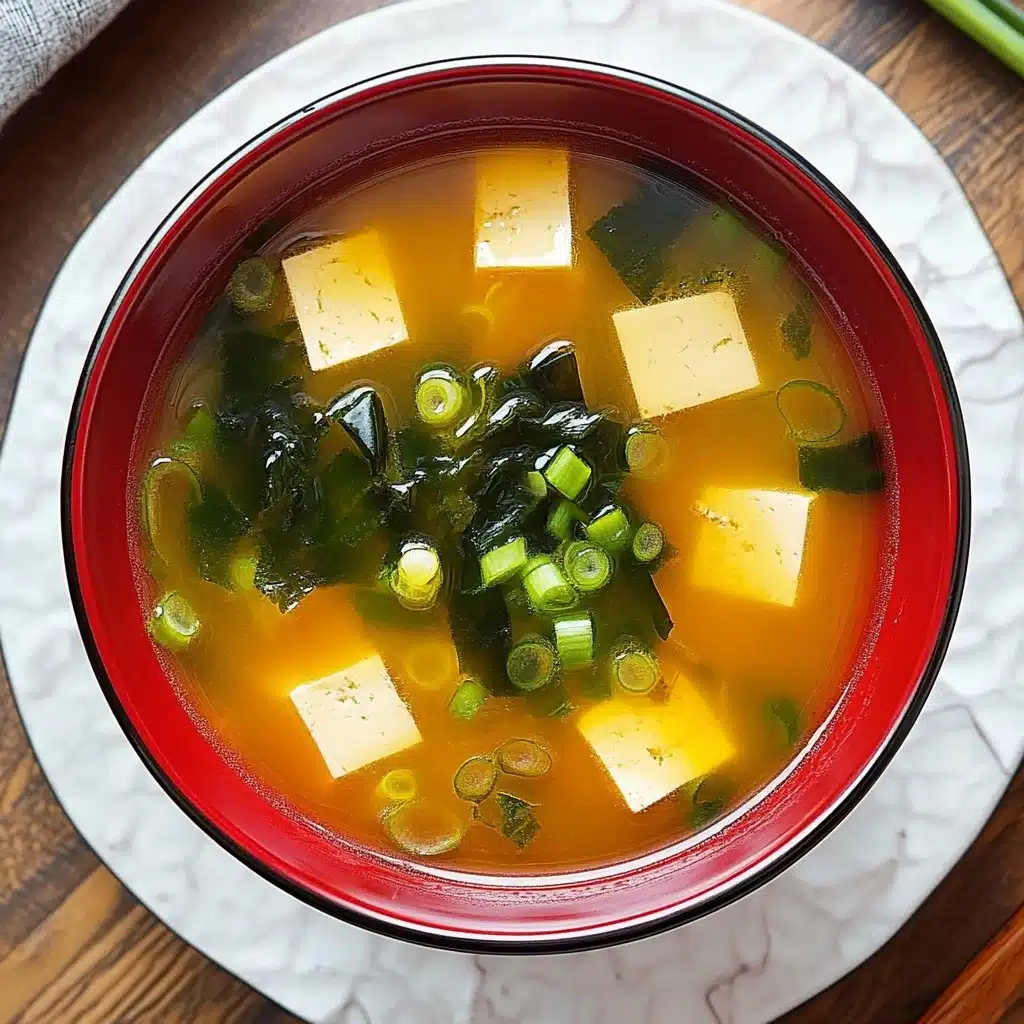Homemade Miso Soup with Tofu is about as comforting as it gets—steamy clouds of savory dashi, creamy-soft tofu, and that irresistible miso aroma wafting from your bowl. This is the cozy, umami-packed Japanese classic you can easily whip up at home for a soul-warming start to any meal.
Why You’ll Love This Recipe
- Fast & Homemade: This miso soup comes together in about 20 minutes—even faster than takeout, and so much fresher.
- Customizable for All Diets: Make it traditional or adapt it easily for vegetarians and vegans with just a quick swap of dashi recipes.
- Restaurant-Quality Flavor: Kombu and katsuobushi create a broth with depth and umami that rivals your favorite Japanese restaurant.
- Perfect Balance of Textures: Silken tofu floats in a delicate, savory broth, with pops of green onion and slippery wakame for a comforting, classic bowl.
Ingredients You’ll Need
The beauty of Homemade Miso Soup with Tofu is how just a few simple, thoughtfully chosen ingredients can create layers of flavor. Each element is essential, from the kombu (kelp) that lays the umami foundation, to silky tofu that makes every spoonful a gentle delight.
- Kombu (dried kelp): This sea vegetable forms the backbone of your dashi, giving the soup subtle oceanic richness and depth.
- Katsuobushi (dried bonito flakes): For classic awase dashi, these add smoky, savory notes—swap for dried shiitake to keep it vegan.
- Soft/Silken Tofu (Kinugoshi Dofu): Tofu brings a creamy, delicate texture—handle it gently for beautiful cubes that soak up the flavorful broth.
- Miso Paste: The star ingredient! Choose your favorite miso (white, yellow, or red)—each brings a slightly different flavor, so play around to find your perfect balance.
- Dried Wakame Seaweed: Just a tablespoon rehydrates into soft, lush greens for that iconic miso soup color and a gentle, briny flavor.
- Green Onion/Scallion: Thinly sliced for a peppery, fresh finishing touch that pops against the creamy tofu and umami broth.
- Water: Simple but crucial—a blank canvas for all those umami-building ingredients.
Variations
Miso soup is wonderfully adaptable—you can keep it traditional or put your own spin on it! Swap out a few ingredients to suit dietary needs, your pantry, or simply what you’re in the mood for. Here are some delicious variations to try:
- Vegan Option: Omit the katsuobushi and use only kombu (or add dried shiitake) for a rich, plant-based broth.
- Different Types of Miso: Try mild white (shiro), robust red (aka), or even mix the two for a balanced, complex flavor.
- Add Extra Vegetables: Enoki mushrooms, baby spinach, or thinly sliced carrots make tasty, colorful add-ins.
- Swap the Tofu: Use firm tofu for a more substantial bite, or fried tofu puffs for even more texture.
- Boost the Umami: Stir in a handful of blanched edamame or a sprinkle of sesame seeds for even richer flavor and visual appeal.
How to Make Homemade Miso Soup with Tofu
Step 1: Prep Your Ingredients
Before you begin, gather all your soup ingredients and equipment. Rinse and slice your green onion into thin rounds, cube your silken tofu gently (about ½ inch pieces), and measure out your miso paste, kombu, katsuobushi, and wakame. Having everything ready will make the whole Homemade Miso Soup with Tofu experience a breeze!
Step 2: Make the Dashi (Broth)
Add 4 cups of water and your piece of kombu to a saucepan. For the best flavor, let the kombu soak in cold water for 30 minutes if you have time. Turn the heat to medium-low, and slowly bring to almost a boil over about 10 minutes—this gentle approach draws out maximum umami. Right before the water boils, remove the kombu (keep it for another recipe!) to avoid bitterness or sliminess.
Step 3: Add Katsuobushi (for Traditional Dashi)
If you’re making classic Japanese dashi, sprinkle in the katsuobushi (bonito flakes) and bring the pot back to a boil. As soon as it boils, reduce to a simmer for 30 seconds—no more! Then, take off the heat and let the flakes settle for 10 minutes. Strain through a fine-mesh sieve into a clean bowl—you’ve just made a batch of fragrant, golden awase dashi!
Step 4: Dissolve the Miso Paste
Return your dashi to the saucepan (or use it straight if just finished). Heat gently until steaming but do not boil—high temperatures can destroy the delicate miso aroma. Scoop the miso paste into a ladle, partially dip it into the broth, and stir with chopsticks or a spoon until melted and smooth. If you have a miso strainer or muddler, use it for the quickest results. Now your Homemade Miso Soup with Tofu broth is brimming with flavor!
Step 5: Add Tofu, Wakame & Scallions
Slide the silky tofu cubes into the soup gently to avoid breaking them. Sprinkle in the dried wakame and, right before serving, toss in the freshly sliced green onions. Let everything warm through for just a minute (no boiling!), so the tofu is heated and the wakame is rehydrated but still vibrant.
Step 6: Serve and Enjoy!
Ladle the steaming miso soup into bowls, being sure to scoop up plenty of tofu, seaweed, and scallion in every portion. Enjoy right away—Homemade Miso Soup with Tofu is best sipped while it’s hot and fresh!
Pro Tips for Making Homemade Miso Soup with Tofu
- No-Boil Zone: After adding miso paste, never let the soup boil—this preserves the miso’s delicate flavor and healthy probiotics.
- Gentle Tofu Handling: Silken tofu is fragile! Use a wide spoon or slide cubes carefully into the broth for those beautifully intact pieces.
- Customize the Broth: Adjust intensity by choosing your miso and whether you use classic (kombu + katsuobushi) or vegan (kombu + shiitake) dashi.
- Prep Ahead Trick: Dashi can be made in advance and kept in your fridge or freezer, making quick homemade miso soup just an arm’s reach away on busy days.
How to Serve Homemade Miso Soup with Tofu

Garnishes
Classic green onions add both color and a fresh, vibrant bite to Homemade Miso Soup with Tofu. For something extra, a sprinkle of toasted sesame seeds or a pinch of shichimi togarashi (Japanese chili pepper blend) brings a little warmth and crunch—perfect for customizing each bowl at the table.
Side Dishes
This soup shines alongside a bowl of steamed rice, maybe with a side of pickled vegetables or a crispy cucumber salad. It’s also a lovely companion to grilled fish, teriyaki chicken, or Japanese omelets on a bigger spread—Homemade Miso Soup with Tofu truly rounds out any Japanese-style meal.
Creative Ways to Present
Serve in delicate lacquered bowls for a traditional touch, or use small ceramic mugs for a cozy weeknight feeling. Let guests add their own fresh garnishes at the table for a fun, interactive experience—think scallions, sesame, or even a swirl of chili oil for extra kick.
Make Ahead and Storage
Storing Leftovers
Homemade Miso Soup with Tofu is at its peak right after you make it, but leftovers can also be stored for later enjoyment. Let the soup cool to room temperature (no more than 4 hours out) before refrigerating in an airtight container. If you know you’re making extra, try storing the broth separate from the miso, tofu, and garnishes for the best flavor and texture.
Freezing
You can freeze the dashi broth on its own for up to two weeks, but it’s best not to freeze miso soup with tofu already in it—the delicate tofu changes texture (it gets a bit spongy and grainy). For best results, freeze just the broth, then finish the soup with miso, tofu, and garnish just before serving.
Reheating
When reheating, use gentle heat and avoid boiling—just warm until steaming. Overheating can make the miso bitter and will diminish its fragrant, savory magic. If your soup was stored without the miso, add the paste only after reheating the broth for the most vibrant taste.
FAQs
-
Can I make Homemade Miso Soup with Tofu completely vegan?
Absolutely! Simply skip the katsuobushi (dried bonito flakes) and create the dashi using just kombu and, if you like, dried shiitake mushrooms. This plant-based broth is richly flavorful and perfectly complements the creamy tofu and savory miso.
-
What type of tofu works best for Homemade Miso Soup with Tofu?
Silken tofu (kinugoshi) is traditional for its delicate, melt-in-your-mouth texture, but soft or even medium tofu will work if that’s what you have on hand. Just handle gently when adding to the broth to keep those lovely cubes intact.
-
Can I use miso paste straight from the fridge, or should I bring it to room temperature?
You can use miso paste straight from the fridge—just make sure to dissolve it completely in a ladle or small bowl with some hot dashi before adding it back to the pot. This way, you’ll avoid clumps and ensure perfect flavor in every bite.
-
Is it okay to let Homemade Miso Soup with Tofu simmer after adding the miso?
It’s best to avoid simmering or boiling the soup once you’ve added the miso paste. High heat causes the delicate flavors and nutrients to deteriorate. Heat gently until just steaming, then turn off the heat and add your miso for maximum flavor.
Final Thoughts
Homemade Miso Soup with Tofu really is the definition of cozy, fuss-free comfort. Whether you’re new to Japanese cooking or already a miso soup devotee, this recipe is sure to become a regular in your kitchen. Try it soon—your future self (and your taste buds) will thank you!
Print
Homemade Miso Soup with Tofu Recipe
- Prep Time: 5 minutes
- Cook Time: 15 minutes
- Total Time: 20 minutes
- Yield: 4 servings
- Category: Soup
- Method: Boiling, Simmering
- Cuisine: Japanese
- Diet: Vegetarian
Description
Learn how to make delicious Homemade Miso Soup with Tofu from scratch. This traditional Japanese soup is flavorful, comforting, and surprisingly simple to prepare.
Ingredients
Dashi:
- 4 cups water
- 1 piece kombu (dried kelp) (1/3 oz, 10 g per piece; 4 x 4 inches or 10 x 10 cm)
- 1 cup katsuobushi (dried bonito flakes) (packed; I used a loosely packed 3 cups in the video for stronger flavor)
Miso Soup:
- 7 oz soft/silken tofu (kinugoshi dofu)
- 4 Tbsp miso (use 1 Tbsp, 18 g for every 1 cup, 240 ml of dashi)
- 1 Tbsp dried wakame seaweed
- 1 green onion/scallion
Instructions
- Dashi 3 Ways
Gather all the ingredients.
- Miso Soup Ingredients
Cut 1 green onion/scallion into thin rounds.
- To Make the Dashi (can make in advance)
Add 4 cups water and 1 piece kombu (dried kelp) to a medium saucepan. If you have time, soak the kombu in water for 30 minutes. NEVER wash kombu and do not remove the white substance—that’s umami! These days, it‘s pretty clean, so just make sure there are no dirt particles.
- Miso Soup 1
SLOWLY bring it to a boil (about 10 minutes) on medium-low heat so you can extract as much umami from the kombu as possible. Right before the stock boils, remove the kombu and set it aside for another use. (If you leave the kombu, it gets slimy and yields a bitter taste.) Now, what you have is Kombu Dashi. If you’re vegetarian/vegan, use this kombu dashi for your miso soup.
- Miso Soup 2
If you‘re not vegetarian/vegan, add 1 cup katsuobushi (dried bonito flakes) to the kombu dashi and bring it back to a boil again. Once the dashi is boiling, reduce the heat, simmer for just 30 seconds.
- Miso Soup 3
Turn off the heat and let the katsuobushi sink to the bottom, about 10 minutes. Then, strain through a fine-mesh sieve.
- Miso Soup 4
Now you have roughly 4 cups of Awase Dashi. You can store the dashi in the refrigerator for up to 3–5 days and in the freezer for up to 2 weeks. Reserve the spent katsuobushi and repurpose it; see the suggested recipes that follow at the end of the instructions.
- Miso Soup 5
Add the dashi to the saucepan. If you are using dashi from the refrigerator, bring it to a slow boil (205°F/96°C) over medium heat and turn off the heat.
- Miso Soup 6
Add 4 Tbsp miso. Put the miso in a ladle, slowly add the dashi into the ladle, and stir with chopsticks to dissolve completely. Here, I‘m using a miso muddler. If you accidentally add too much miso, dilute the miso soup with dashi (or water).
- Miso Soup 7
Here, I‘m using a fine-mesh miso strainer, which helps you dissolve the miso faster. After dissolving the miso in the strainer, you may see rice koji (especially when it‘s koji miso). It‘s up to you if you want to include it in the miso soup or discard it (personal preference).
- Miso Soup 8
Cut 7 oz soft/silken tofu (kinugoshi dofu) into ½-inch (1.3 cm) cubes and add to the miso soup. Tip: Add the tofu after the miso is completely dissolved; otherwise, you might break the tofu when stirring in the miso. Note: It is very common to cut tofu on your palm in Japan. However, I recommend using a cutting board if you have never done this.
- Miso Soup 11
Add 1 Tbsp dried wakame seaweed and the chopped green onions to the pot right before serving to keep their fresh fragrance and color.
- Miso Soup 12
Serve immediately. Place on the right side of the table setting; you can read about this in my post Ichiju Sansai (One Soup Three Dishes).
- To Store
In general, it‘s best to consume all the miso soup right away because it will lose its aroma and taste as time passes. Let your miso soup cool to room temperature (up to 4 hours; any longer and it will spoil) and then refrigerate. Keep for up to 2 days in the refrigerator. If you want to make a big batch to store for later, it‘s best to refrigerate the soup without adding the miso. When ready to use, add the miso only for the portion you need. You can freeze miso soup for up to 2 weeks. However, you have to remove the tofu before freezing as the texture will change.
- To Reheat the Miso Soup
Heat the miso soup in a pot over medium heat, but do not boil. Miso loses its nutrients, flavor, and aroma at high temperatures.
Notes
- If you accidentally add too much miso, dilute the miso soup with dashi (or water).
- Do not wash the kombu and do not remove the white substance as it adds umami to the dashi.
- Rehydrate the dried wakame in a separate bowl of water to reduce saltiness.
- It’s best to consume miso soup right away for optimal flavor.
Nutrition
- Serving Size: 1 bowl (approximately 1 cup)
- Calories: 110
- Sugar: 2g
- Sodium: 850mg
- Fat: 4g
- Saturated Fat: 1g
- Unsaturated Fat: 3g
- Trans Fat: 0g
- Carbohydrates: 12g
- Fiber: 2g
- Protein: 7g
- Cholesterol: 0mg









